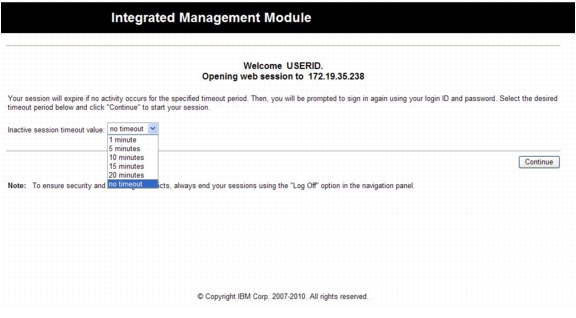

Table Of Contents
Opening and using the IMM Web interface
Accessing the IMM Web interface
Opening and using the IMM Web interface
The IMM combines service processor functions and a video controller in a single chip. To access the IMM remotely by using the IMM Web interface, you must first log in. This chapter describes the login procedures and the actions that you can perform from the IMM Web interface.
Accessing the IMM Web interface
The IMM supports both static and Dynamic Host Configuration Protocol (DHCP) IP addressing. The default static IP address assigned to the IMM is 192.168.70.125. The IMM is initially configured to attempt to obtain an address from a DHCP server, and if it cannot, it uses the static IP address.
The IMM provides the choice of using a dedicated systems-management network connection or one that is shared with the server.
For setting up the IMM network connection, the approach depends on the product. For example, the Cisco Flex 7500 Series Wireless Controller provides a CLI command to configure IMM access, whereas the Cisco 3355 Mobility Services Engine provides a script (immconfig.sh). Refer to the product-specific configuration document for details.
Logging in to the IMM
Important: The IMM is set initially with a user name of USERID and password of PASSW0RD (with a zero, not the letter O). This default user setting has Supervisor access. Change this default password during your initial configuration for enhanced security.
To access the IMM through the IMM Web interface, complete the following steps:
Step 1
Open a Web browser. In the address or URL field, type the IP address or host name of the IMM server to which you want to connect.
Step 2
Type your user name and password in the IMM Login window. If you are using the IMM for the first time, you can obtain your user name and password from your system administrator. All login attempts are documented in the event log. Depending on how your system administrator configured the user name, you might need to enter a new password. The default user name is USERID and the default password is PASSW0RD (with a zero).
Step 3
On the Welcome Web page, select a timeout value from the drop-down list in the field that is provided. If your browser is inactive for that number of minutes, the IMM logs you off the Web interface.
Note
Depending on how your system administrator configured the global login settings, the timeout value might be a fixed value.
Step 4
Click Continue to start the session.
The browser opens the System Status page, which gives you a quick view of the server status and the server health summary.
For descriptions of the actions that you can perform from the links in the left navigation pane of the IMM Web interface, see "IMM action descriptions" section. Then, go to Chapter 3, "Configuring the IMM".
IMM action descriptions
Table 2-1 lists the actions that are available when you are logged in to the IMM.
You can click the View Configuration Summary link, which is in the top-right corner on most pages, to quickly view the configuration of the IMM.

 Feedback
Feedback


